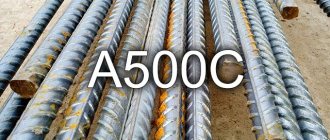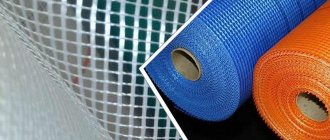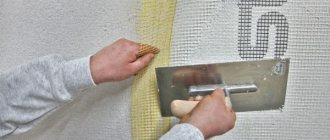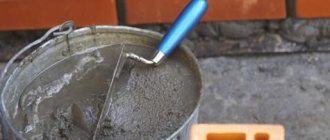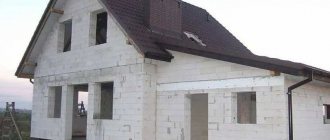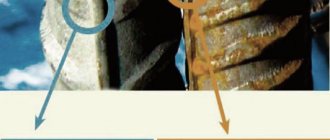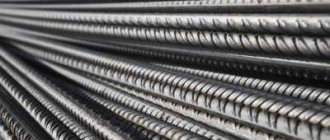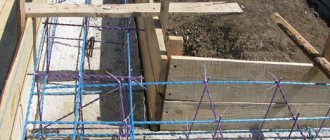Due to the active introduction of new technologies into the construction industry, many experts are wondering which reinforcement will better solve the problem of strengthening concrete structures: metal or fiberglass? To make a reasonable choice, you should understand the advantages that fiberglass reinforcement has over its metal counterpart. Despite its relatively recent appearance, it has already gained enormous popularity in the building materials market.
Fiberglass or metal?
Advantages and disadvantages of metal
To begin with, metal rods of classes A240, A300, A400, etc. have been used in construction for decades and have proven themselves to be excellent. Experienced builders highlight the following advantages of this material:
- high strength;
- resistance to temperature changes (works up to 600°C);
- durability and environmental friendliness. Even with prolonged use in extreme conditions, the material does not emit substances hazardous to health;
- good plasticity - you can change the shape without heating and specialized equipment;
- weldability - welding of reinforcement marked with the letter “C” is allowed, for example A500C;
- complete fire safety. In direct contact with fire, it does not collapse, much less support combustion.
Unfortunately, there are also disadvantages. The main one is the fear of moisture. If for some reason the concrete becomes covered with cracks and moisture gets on the reinforcement, then the corrosion process will start, which will subsequently lead to the destruction of the rod and a decrease in the strength of the reinforced concrete product. Of course, you can choose special reinforcement for the foundation with the letter K - corrosion resistance. Indeed, there are grades of steel that are not subject to corrosion. But their cost is higher.
Also, the disadvantages include the much greater weight of metal reinforcement compared to composite reinforcement.
Main advantages
Among the advantages of carbon fiber reinforcement, it is worth highlighting the following.
An important advantage of fiberglass reinforcement is its low specific weight, which makes it possible to use it for reinforcing light structures made of cellular concrete and some other building materials. This allows you to significantly reduce the weight of structures that are reinforced with its help. Meanwhile, the weight of a conventional concrete structure when using fiberglass reinforcement will decrease slightly, since the building material itself has an impressive mass. Low thermal conductivity is also an advantage of fiberglass reinforcement. When using such reinforcement in concrete structures, no cold bridges are formed (which cannot be said about metal reinforcing elements), which significantly improves their thermal insulation parameters. The high flexibility of fiberglass reinforcement allows it to be shipped to the customer in coils, rather than cut into individual rods. Thanks to the compact form of packaging, it is much easier to transport such reinforcement, for which you can use the trunk of any passenger car, and this seriously reduces the cost of delivering the material to the construction site. The use of reinforcing elements, which are shipped not in cut rods, but in coils, also makes it possible to reduce material costs by reducing the number of overlaps
This has a positive effect on both the strength characteristics of the future concrete structure and its cost, which is especially important when performing construction work. The advantage of fiberglass reinforcement, such as its durability inside a concrete structure, is considered quite controversial. Metal fittings, being in an isolated state, are also not subject to the negative influence of external factors, which ensures the durability of its use. Carbon fiber reinforcement is a dielectric material, which is an advantage of products made from this material
Electrically conductive metal fittings are more susceptible to corrosion, which negatively affects its durability. Compared to metal reinforcing elements, fiberglass products are not exposed to chemically active environments. This advantage of fiberglass reinforcement is especially important in cases of construction of buildings in winter, when various salt solutions are added to the concrete, accelerating the hardening process. Being a dielectric, carbon fiber reinforcement does not create radio interference inside the building, unlike metal rods. This advantage is important when there are many reinforcing elements in a concrete structure. Otherwise, the use of composite reinforcement will not be a disadvantage, but it will not be so relevant.
The main advantages of composite reinforcement
Fiberglass reinforcement also has disadvantages, which potential consumers should also be aware of.
Consider fiberglass
The advantages of fiberglass reinforcement are undeniable - it is thanks to them that it has gained such popularity today. Composite reinforcement has the following advantages compared to steel:
- Lighter weight, making it easier to transport and greatly facilitate the process of use.
- Better withstands tensile loads. Therefore, many builders use fiberglass reinforcement in cases where it is necessary to ensure the reliability of especially critical concrete structures.
- It is not afraid of moisture, due to which it can be used in the construction of concrete products in direct contact with water.
- Has low electrical and thermal conductivity.
- Environmentally friendly material.
- In terms of the coefficient of thermal expansion, fiberglass reinforcement (FRP) is closer to concrete, which reduces the risk of cracks in finished products during frequent heating and cooling, since the reinforcement will expand and contract along with concrete, which is especially important for many regions of our country.
Alas, even composite reinforcement has disadvantages. First of all, experienced builders highlight low elasticity. Under mechanical loads, the deflection of metal reinforcement is less. In some cases, for example, when laying a foundation or making slabs for a road surface, this drawback is not significant. However, if you need high-quality and reliable floor slabs for the construction of a multi-story building, then it makes sense to give preference to old, proven reinforced concrete products.
Fiberglass reinforcement should not be bent at the construction site - this can lead to its destruction or reduction in load-bearing capacity. With a simple machine, metal can be bent at a very significant angle.
Of course, plastic should never be welded - the reinforcement frame for the foundation and any other concrete products is assembled exclusively using binding wire. With metal, options are possible - some types of rods can be connected using conventional welding. Fiberglass reinforcement loses its load-bearing properties at 150°C.
How to connect - welding or knitting
There are two different connection methods - welding and knitting, but in the case of plastic reinforcement it will not be possible to use the welding method. If you heat this material to at least 200 degrees Celsius, it will collapse.
A frame made of metal reinforcement is also not recommended to be assembled by welding, as it fails faster due to poor load bearing capacity at the welding points. Also, which is bad, corrosion forms faster in welding joints.
In both cases, the best option is to use knitting. A special crochet hook is used for this. The specialist only needs to thread the wire and then the hook into the loop that appears, after which all that remains is to twist it as tightly as possible. This is the simplest, most reliable and cheapest method, used by builders for many years.
In the case of strip foundations, knitting guns are often used. These devices can facilitate and speed up the joining process, but the cost of a knitting gun can reach 50,000 rubles. You will also need to acquire special wire. Without it, the knitting gun may break, and its repair is quite expensive.
What to choose?
After the main advantages and disadvantages of the characteristics of both materials are listed, it is time to say which reinforcement will be the best choice.
In general, it is impossible to say for sure which is better – fiberglass or metal reinforcement. Both options have a number of important advantages. Therefore, it is especially important to use each material in its appropriate field. That is, if high elasticity is a particularly important parameter (for example, in the construction of multi-story residential and office buildings), then it is better to choose a proven metal rod - it will not bend even with a large length and load. But if resistance to corrosion is one of the important requirements (construction of bridge supports, coastal fortifications), then an expert who prefers a fiberglass analogue will not be mistaken.
Finally, we need to highlight one more question that builders always have - what is cheaper, composite reinforcement or metal? The question is very difficult. On the one hand, the cost of a meter of a metal rod with a diameter of, for example, 10 millimeters is lower than that of a plastic analogue. On the other hand, strength must be taken into account. Tests show that a 10mm composite rod can withstand the same load as a 14mm steel rod. If we consider the issue comprehensively, we can conclude that the cost of the material is approximately the same. There is a difference, but it is so small that it is not worth making a choice based on it.
Section selection
When deciding which reinforcement is best for the foundation, it is imperative to take into account the diameter. This parameter is of key importance for all construction. If you are going to use a thick rod made of metal or plastic, then it will withstand a much greater load than a thinner rod. However, the diameter of the rods directly affects their cost and especially weight, which means the principle, the thicker the better, does not fit, you need to look for a middle ground. Therefore, before choosing a particular diameter, you must carefully study the information provided.
When selecting the cross-section of the main working reinforcement, the cross-section will have to be taken into account. This applies to all types of foundations, including strip foundations. In order to perform all the calculations, you need to use a tape measure and a calculator. You should also remember about the length of the reinforcement. If it exceeds 3 meters, then the diameter must be equal to 0.1% of the total cross-sectional area, but the minimum diameter must be at least 1 cm. If the length exceeds 3 meters, then the minimum diameter must reach at least 1.2 cm. Experienced and qualified a private foreman will be able to make the most competent decision, so if you have doubts, it is better to seek professional help.
After all the measurements have been taken, you will be able to find out the required diameter, which will allow you to avoid paying too much money when purchasing the material. By knowing the optimal cross-section size, you can achieve exceptionally high durability, as well as reliability of the entire structure.
Helpful information
The diameter of the horizontal rods is at least 6 mm.
The diameter of vertical rods for a foundation height of up to 800 mm is at least 6 mm.
The diameter of vertical rods for foundation heights over 800 mm is at least 8 mm.
Features of fiberglass
Reinforcement made of fiberglass is a rod, the diameter of which can be in the range of 4–18 mm, and the length can be up to 12 meters. It is made from heavy-duty plastic. During its manufacturing process, spiral-shaped ribs are applied to the surface of such a rod, thanks to which its reliable adhesion to concrete structures is ensured.
Plastic reinforcement, when compared with metal products for similar purposes, due to its strength characteristics and corrosion resistance, makes it possible to create more reliable and durable frame structures, which explains the popularity that this material is actively gaining.
We recommend reading: What is the best material to make a blind area around the house from?
Comparison of the characteristics of metal and composite reinforcement
It is also important that reinforcement made of fiberglass, unlike metal products, requires special production conditions, the use of high-quality raw materials and special equipment, so its production in artisanal conditions is excluded. That is why, when purchasing reinforcement made of fiberglass on the modern construction market, you can be sure that this is a material made in full compliance with the requirements of the relevant regulatory document.
The unique characteristics of reinforcement made of fiberglass are explained by the properties of its structure, which includes:
- internal rod providing reinforcement strength; such a rod is made of parallel fiberglass fibers securely connected with a polymer resin;
- the outer layer, which is a fibrous body wound in a spiral around the inner rod; This layer of fiberglass can be applied using sand-spray or bi-directional winding technology.
Fiberglass reinforcement is better than steel, it works in compression by 30%, and in tension by 20%
Fiberglass reinforcement, depending on the preferences of the manufacturer, can be manufactured using various methods. Thus, on the modern market it is possible to find products whose internal rod is made in the form of a pigtail made of fiberglass.
Advantages and disadvantages of fiberglass reinforcement
Reinforcement frames made not from traditional metal, but from fiberglass elements, have the following advantages.
- Unlike metal ones, they are lightweight structures that do not create a significant load on the foundation of the building, which allows you to extend its service life.
- Fiberglass elements of reinforcing frames, unlike their metal counterparts, better tolerate tensile loads, which makes it possible to use them in strengthening the most critical concrete structures. Fiberglass reinforcement frames are characterized by an optimal ratio of their light weight and high strength, which allows them to be classified as a separate group of building materials that are gaining more and more popularity every year.
- Unlike metal reinforcement, which is subject to oxidation processes and over time reduces the strength of foundation structures, frames made of fiberglass elements are not influenced by such negative environmental factors.
- Parts of reinforcement systems made of fiberglass are dielectric and do not conduct electric current, which also affects their durability. Metal reinforcement structures used as grounding elements oxidize much faster under the influence of electric current, which cannot be said about rods made of composite materials. Naturally, fiberglass reinforcement cannot be used as a grounding element, but this only has the most positive effect on its durability.
- The wear resistance of fiberglass reinforcement structures, like steel ones, is also at a fairly high level.
- The coefficient of thermal expansion of a reinforcement frame made of fiberglass elements has a very similar value to that of concrete structures, which significantly reduces the risk of cracks forming in them when using such a material.
The ratio of the diameters of the rods when installing the reinforcing frame of the foundation
Judging by the reviews, we can highlight the following disadvantages of fiberglass reinforcement.
- Compared to metal products, fiberglass reinforcement has a significantly higher modulus of elasticity, approximately 4 times higher than that of steel products. This fact means that fiberglass elements, compared to metal ones, will bend much better under the influence of mechanical loads. When using these elements to reinforce the roadway and foundation, this characteristic is not critical, but to strengthen floor slabs it is better to use metal structures or make additional calculations.
- Reinforcing elements made of fiberglass tend to soften greatly and lose their elasticity when heated to a temperature of 600 degrees. Therefore, when using fiberglass parts, it is better to take care of reliable thermal insulation of the frame made from composite materials.
- Reinforcing bars made of fiberglass cannot be welded, unlike metal ones, so if there is a need for such an operation, it is better to use products in the inner part of which a steel tube is installed at the stage of their production.
- It is better not to bend reinforcement made of composite materials on the construction site: this can cause damage. This operation, based on the drawings of the reinforcement cage, is best performed at the production site.
- The complexity and unusual installation technology for modern builders is another drawback of reinforcing elements made from fiberglass. Meanwhile, such a disadvantage cannot be considered too significant, given the reliability and durability of fiberglass structures.
Fastening fiberglass reinforcement using clamps and clamps
Foundation reinforcement technology
Thanks to the reduced weight of plastic reinforcement and the ability to use rods of any length, assembling a reinforcing frame is much easier than using metal rods. The increased strength of polymer reinforcement for foundation materials allows the use of a smaller cross-section.
For example, steel reinforcement with a diameter of 12 mm, often used for installing foundations in private construction, is replaced with 8 mm plastic, and 10 mm rods with 7 mm polymer.
A calculation table that will help you determine exactly what diameter can be used in each individual case.
The technological process of installation work using plastic reinforcement for the foundation is carried out in several stages, as shown in the video at the end of the article:
- installation of formwork;
- marking the concrete pouring level;
- assembly of the reinforcing frame;
- pouring concrete;
- removal of formwork.
Installation of the formwork structure when reinforcing a strip foundation with fiberglass reinforcement must be carried out in accordance with the design to ensure the exact configuration and dimensions of the foundation elements. When constructing formwork from wooden boards, chipboard or plywood, it is recommended to wrap the panels in glassine. This will save the material and reuse it.
After this, on the inside of the enclosing elements, using a water level, it is necessary to mark the upper level of the future monolith. They will allow you to navigate when pouring concrete and ensure its even distribution.
Assembly of the reinforcing frame
The layout of the reinforcement and the dimensions between individual rods are always indicated in the project. If you use fiberglass reinforcement in the foundation, you can change the diameter of the rods to a smaller one, but the layout should be done only according to the drawing.
Scheme of reinforcement of a monolithic slab.
Initially, it is necessary to unwind rods of the required length from the coil and install them on stands parallel to each other. At specified intervals, place transverse bridges on the longitudinal strings. Tie the reinforcement at the intersections with tying wire or tighten it with tight plastic clamps (more about tying here). As a result, the bottom row of the frame will be ready for reinforcing the foundation with fiberglass reinforcement.
Prepare vertical posts of the required length. The top row of the frame is knitted similarly to the bottom row. After assembly, both rows are placed on top of each other and, starting from the edge, their vertical posts are connected, gradually raising the top row of reinforcement.
After assembling the structure, it must be moved and installed inside the formwork fence, as shown in the photo.
Before installing the reinforcing frame, sand is poured into the bottom of the trench and spilled with water or compacted. It is recommended to cover the compacted sand surface with waterproofing material or geotextile fabric. This will prevent moisture from entering the foundation and increase its reliability and service life.
In the process of installing a foundation made of fiberglass reinforcement, it must be remembered that the edges of the rods should not reach 5 cm from the formwork and the bottom of the trench. To ensure this condition, you can use special plastic fasteners such as “post” and “star” or dense moisture-resistant stone materials.
Belt reinforcement.
Pouring concrete mixture
Laying concrete inside the formwork is done in exactly the same way as when using metal reinforcement
However, extreme caution should be exercised, since the strength of fiberglass reinforcement may be insufficient under strong lateral impacts. Compacting concrete with a vibrator or tamper must be done in such a way as not to damage the installed frame
Application of reinforcement made of fiberglass materials
The unique characteristics of fittings made from fiberglass materials allow them to be used in a wide variety of areas. Thus, this material is successfully used in the following areas:
- strengthening foundation systems, especially those of the strip type;
- reinforcement of concrete structures that play the role of supporting elements, in particular, power line supports;
- strengthening concrete elements of various fences, bridge systems, road surfaces;
- reinforcement of railway track elements, paving slabs;
- strengthening of concrete structures subject to high corrosion and dynamic loads: berths, dock structures, etc.;
- strengthening of coastal structures;
- installation of sewerage and reclamation structures;
- use as rods and mesh systems in agriculture and various industries;
- installation of earthquake-resistant belts in concrete structures for various purposes.
We recommend reading: Foundation for a house made of wood concrete: structure, installation features
An example of the use of composite reinforcement in the construction of walls using permanent formwork technology
Reinforcing elements made of fiberglass are an innovative material, the use of which helps to avoid cracks and destruction in concrete structures. The advantage of its use is that it is able to maintain its characteristics over a long period of time, which cannot be said about its metal counterpart. Meanwhile, when choosing which reinforcing elements are best to use, you should keep in mind that products made of composite materials, which have recently appeared on the construction market, have not yet undergone long-term testing in practice.
Which reinforcement to choose: fiberglass or metal, each user decides for himself, but products made of fiberglass and other composite materials are favored by their mechanical characteristics, reliability and durability.
What is better to use for the foundation and in what cases
It is impossible to unequivocally answer the question - which is better, plastic or metal reinforcement for a foundation, but it should be remembered that in industrial and civil construction they traditionally continue to use a metal rod for the construction of a foundation.
The technical characteristics of fiberglass do not allow its use in the construction of large construction projects. When designing multi-storey buildings, power plants, and industrial buildings, only steel reinforcement is used.
It is allowed to use fiberglass reinforcement for assembling foundation frames during the construction of the following objects:
- In low-rise construction for pouring strip foundations.
- For pouring supports under poles and bases for fences.
- Berths, coastal structures, docks.
- Foundations for sewer systems.
- Supporting elements of bridges.
In other cases, there is no alternative to traditional metal frame knitting.
The difference between fiberglass and steel reinforcement
Composite reinforcement is an analogue of metal rods. For the manufacture of such products, fiberglass, high-strength plastic, basalt, aramid, carbon and other materials are used. The fibers are produced with a diameter of 4-12 mm in coils of 100 m, impregnated with thermosetting resins (epoxy, epoxy-diane, vinyl ester) and baked in special ovens. To enhance adhesion to concrete, spiral-shaped ribs are applied to the surface of the composite rod; reinforcement with a conditionally smooth surface with sand sprinkling is also available.
Unlike conventional metal reinforcement, composite rods have lower weight, corrosion resistance, and dielectric properties. Steel rods, frames and reinforcing mesh have high strength to various types of deformation (bending, compression) and can be installed using welded equipment (one of the main differences from fiberglass). Composite products have some restrictions on their use; they are not used in beams, floors and other structures with high bending loads.
Main differences and application features
Steel reinforcement is a metal core with a given cross-section, the strength, corrosion resistance and elasticity of which are determined by the properties of the steel used. It has a diameter of up to 80 mm and a ribbed surface for anchor hooks. It is supplied in 12 meter lengths, which can be cut if necessary.
Composite reinforcement is carried out with a composite rod, which is based on fiberglass fiber bonded with polymer resins. Mineral materials are sprayed onto it or fibers are wound onto it. This is done to improve adhesion to concrete, which increases the strength of the monolith. Supplied in lengths or coils, up to 100 m long.
Metal and plastic fittings are similar, but there are differences that are taken into account when used. Fiberglass is much lighter and does not corrode. Therefore, it is suitable for low-rise construction, foundations, buildings and structures on marshy soils and other places with high humidity.
Metal reinforcement has increased elasticity, so it can withstand short-term dynamic loads well. It does not collapse under the influence of high temperatures, therefore it is used for the construction of bridges and industrial facilities with increased fire safety requirements.
Technical features of fiberglass reinforcement
Fiberglass products are an economical alternative to steel reinforcement. They are made from various materials with different technical characteristics. This type of rods is suitable for the manufacture of concrete, gypsum, and silicate structures.
Advantages of fiberglass reinforcement:
- Light weight.
- Resistant to moisture and chemicals.
- Dielectric properties. Fiberglass does not conduct electric current, which oxidizes the metal.
- Low coefficient of thermal expansion, close to similar characteristics of concrete. This characteristic reduces the risk of cracks in concrete structures.
- Does not interfere with radio signals.
- Large selection of sections and lengths of rods.
- Ease of transportation.
Flaws:
- Low fire resistance.
- Small operating temperature range.
- Low bending and compressive strength. The rods can stretch even when pouring concrete, which requires additional control during reinforcement.
- Complicated installation. Fiberglass cannot be welded; plastic clamps are used as connecting elements, which are not highly reliable. If it is necessary to use a welding machine, composite rods with a steel rod are used.
Composite rods are used in the construction of screeds, decking, road surfaces, as well as in the manufacture of fences, panel and frame structures with low loads, and the construction of coastal, sewer, reclamation and other structures. When installing fiberglass rods, it is not recommended to bend them - under such influences, the surface of the rod may be damaged.
Features of steel reinforcement
Iron reinforcing bars are widely used in the construction of residential and industrial buildings, industrial structures, supports, and road surfaces. They are manufactured in the form of steel rods with a smooth or corrugated surface with a cross-section of 6-40 mm. Metal fittings are classified according to the configuration of the product, resistance to various loads and the method of their distribution, operating principle, and manufacturing technology.
According to their purpose, steel rods are divided into the following types:
- Assembly. Used in the manufacture of frames.
- Distribution. Rods designed to evenly distribute the load and hold the structure in a certain position.
- Workers. Rods with high resistance to tensile and slip loads. They are used in the construction of foundations, the manufacture of beams and crossbars.
- Anchor. Embedded assembly units built into building structures, technological and engineering devices, pipelines.
Based on the loads that the reinforcement takes on, it is divided into longitudinal and transverse. Longitudinal prevents the appearance of vertical cracks, transverse prevents ruptures from sliding stresses.
Metal reinforcing products are marked in accordance with the class, diameter and purpose of the rods. Products are also engraved taking into account their properties - corrosion resistance class, reinforced structure with high fluidity, and the ability to be welded into a single structure. Rods 6-12 m long are sold in bundles or packs.
Advantages of iron reinforcement:
- High resistance to deformation.
- Good adhesive properties.
- Fire resistance.
- Wide range of operating temperatures, including low. Critical heating and cooling do not lead to changes in technical parameters.
- Versatility, application in various types of structures.
- Possibility of different installation methods - by welding or tying with cold-rolled wire.
Flaws:
- Considerable weight.
- Susceptibility to corrosion.
- Thermal conductivity. This property can lead to freezing of the structure at low ambient temperatures.
- Higher cost (compared to fiberglass counterparts).
Comparison of steel and composite reinforcement
comparison table
| Characteristics | Metal rods | Composite rods |
| Material | Steel | Fiberglass, other materials bound with polymer or thermosetting resins |
| Diameter, mm | 6-40 | 4-12 |
| Length, m | 6-12 | 6-100 |
| Weight, kg/l.m. | from 0.03 | from 0.222 |
| Corrosion resistance | Corrodes | Belongs to stainless materials of the first group of chemical resistance |
| Thermal conductivity | 0.35-0.5 W/m*K | up to 47 W/m*K |
| Electrical conductivity | Yes | No, dielectric |
| Temporary tensile strength | 0.37-1.23 kN/mm2 | 1.25 kN/mm2 |
| Elastic modulus | 200 kN/mm2 | 30-55 kN/mm2 |
| Tensile strength, MPa | 390 | 1200 |
| Operating temperature range | up to + 1200°С | -15°С — + 160°С |
| Lifetime | Varies, determined by building codes | Up to 80 years old |
We recommend reading: Varieties of modern formworks
If we compare the capabilities of glass composite and metal, we can highlight a number of advantages for both types of reinforcement. The choice of the optimal material and characteristics of reinforcing bars should be made taking into account the purpose, strength and durability requirements of the structures in which they will be used. When comparing the cost ratio of composite to metal reinforcement, fiberglass reinforcement products win.
Comparison of characteristics
To choose between metal and composite reinforcement, you need to compare their characteristics. More details can be found in the table:
| Characteristics | Metal fittings | Fiberglass reinforcement |
| Tensile strength | 360 MPa | 1200 MPa |
| Elastic modulus | 200000 MPa | 55000 MPa |
| Relative extension | 25% | 2,2% |
| Behavior under load (stress-strain relationship) | Curved line with yield plateau | Straight line with elastic-linear dependence before failure |
| Density | 7 t/m³ | 1.9 t/m³ |
| Corrosion resistance | Corrodes with the release of rust products | Stainless steel material of the first group of chemical resistance, including to the alkaline environment of concrete |
| Thermal conductivity | 47 W/m⁰С | 0.35 W/m⁰С |
| Electrical conductivity | Electrically conductive | Dielectric |
| Environmental friendliness | Eco-friendly | Does not emit harmful or toxic substances |
| Parameters of equal-strength reinforcement frame at a load of 25 t/m² | When using 8A-III, the cell size is 14x14 cm. Weight 5.5 kg/m² | When using ANK-SP 8, the cell size is 23x23 cm. Weight is 0.61 kg/m². Weight reduction by 9 times |
Each of the materials has its own advantages, for example, fiberglass is more resistant to tearing, but has a lower elastic modulus than steel. When designing a building and structures, this is taken into account in order to obtain the required strength with a minimum amount of materials.
Application area
Despite all the existing advantages of fiberglass reinforcement, it should be used with great care. It is better to first consult with specialists who are not interested in promoting this product. The main reason for this is the fundamental differences between the materials: concrete and fiberglass.
In fact, there are no results of independent examinations; all technical characteristics are declared by the manufacturers, after local experiments. Moreover, companies sometimes make completely different statements, since their production technologies differ significantly. Manufacturers' complaints remain only complaints and do not constitute a regulatory framework. Thus, the tensile strength of fiberglass is 4 times higher than that of metal, but the behavior of the material directly depends on the direction of the load vector. Therefore, the real indicators of this parameter still remain incognito.
Metal fittings welded into the structure
SNiP52-01 has been developed regarding the use of fiberglass reinforcement, but it contains only general requirements. Therefore, it is advisable to use metal products for critical reinforced concrete structures.
Price issue
When comparing two variations of fittings, one cannot ignore the issue of pricing policy. Yes, at first glance, the cost per meter of a fiberglass product is higher than that of a similar metal product. But there is one caveat. With the same strength, fiberglass reinforcement has a smaller cross-section than similar steel reinforcement. Therefore, elements identical in their parameters will have approximately the same cost.
There is no clear answer as to which is better – metal or fiberglass. It all depends on the characteristics of the object being built and the technical conditions of its use.
Flexural strength
The parameter depends on the elastic modulus of the material. For steel grade St3 its value is 200 GPa (gigapascals), for fiberglass - 30–55 GPa. This means that in structures where the reinforcement works in bending (all types of floating foundations, floor slabs and beams, lintels over openings and building frame crossbars), the diameter of fiberglass reinforcement must be larger than steel. How much? This requires a specific design calculation. The problem is that the methodology for such calculations has been developed only for reinforced concrete (SP 63.13330.2012), but it is not available for concrete with composite reinforcement.
Practitioners advise that when using fiberglass reinforcement in the listed structures, increase the reinforcement coefficient by approximately 20% or the diameter of the rods by 4 mm (compared to steel). That is, the profitability of using a composite in this case remains in question.
Summary
With comparable characteristics of materials, the main attention is paid to price. It is higher for fiberglass reinforcement, but this is at first glance. For example, if a project requires using a 6 mm metal rod to reinforce concrete, then it can be replaced with a 4 mm fiberglass rod. One ton will contain 4504 linear meters of steel reinforcement. In fiberglass - 50,000 linear meters. m. As a result, the cost of reinforcement will be approximately the same. Also, the use of plastic reduces the overall weight of the structure, which reduces the pressure on the foundation and soil.
Comparison table
It is also impossible to give an unambiguous answer regarding the characteristics - a separate analysis of the technical conditions is required for a specific project. Fiberglass is suitable for armored belts and strengthening the walls of buildings. It is used for foundations in low-rise construction, especially on wet soils. For large buildings it is better to use metal reinforcement due to its higher elastic modulus.
Tensile strength
For fiberglass reinforcement it exceeds 1.1 GPa, for steel it is 390 MPa, that is, approximately three times lower. At the same time, the relative elongation at break (that is, the amount of deformation at temporary tensile strength, expressed as a percentage of the original length) for fiberglass reinforcement is 10 times less. This means that in structures that experience mainly tensile loads (piles, vertical and bottom horizontal reinforcement of deep strip foundations), fiberglass reinforcement can be thinner than steel. Alas, this is just a theory. Accurate calculation methods for fiberglass have not yet been developed.
Thermal conductivity
Thermal conductivity is important mainly in masonry wall structures, where belt reinforcement often leads to the formation of cold bridges. And here, fiberglass reinforcement places steel on both blades: its thermal conductivity coefficient is 13 times lower than that of steel.
“Polyarm” Distance stands help to position the reinforcement in the thickness of the concrete layer.
“SML-52” When installing thick slabs, two-level reinforcement holders are used.
Fundament SPBComposite reinforcement can be knitted with stainless wire using a regular hook or an electric gun.
“Thick wall” In floor screeds and thin slabs, you can sometimes do without spacers.
Ease of use
In this parameter, fiberglass reinforcement differs little from steel. It is much lighter, but in individual low-rise construction the weight of the reinforcement is insignificant. Fiberglass cannot be welded, but today they prefer to knit steel reinforcement with stainless wire or plastic clamps. Cutting composite reinforcement with a grinder is very easy. The only important nuance: a fiberglass rod cannot be bent at a construction site, and bent products ordered from the manufacturer will be expensive, and you will have to wait a long time for them. The lack of rigid continuous reinforcement in the corners may affect the strength of the structure, but there is a way out: nothing prevents you from combining straight fiberglass rods with bent steel ones.
Price
In general, fiberglass reinforcement is cheaper than steel. But, as can be seen from the table, with an increase in diameter, the percentage difference (and therefore the cost according to the estimate) is leveled out.
If the price of steel products from large sellers is more or less the same, then in the case of fiberglass there is a significant variation in prices, depending on the quality (manufactured according to GOST or specifications).
In any case, it is better to buy composite reinforcement from representatives of the largest companies, PlastComposite, Yaroslavsky and others.
| Diameter, mm | Steel reinforcement, price in rubles. | Composite reinforcement, price in rubles. |
| 8 | 25 | 20 |
| 10 | 35 | 25 |
| 12 | 45 | 35 |
| 14 | 55 | 45 |
| 16 | 65 | 55 |
